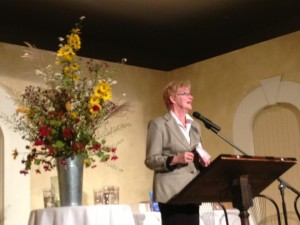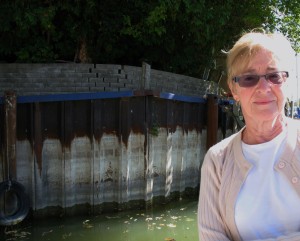
Peter Sinclair is tall and brawny, and while the climate change communications expert looks like he could scale a mountain or scramble a glacier (and soon he will), he doesn’t look like a baseball player on steroids. What looks like a baseball player on steroids, he says, is climate change. While a baseball player on steroids may have an overall improved performance, like more home runs, it’s not possible to connect the steroids to any single home run. Climate change and global warming is the same way, says Sinclair, climate change causes cumulative losses, sometimes devastating to earth and humanity. The overall trend is that climate change contributes to weather extremes, and it is happening at a more frequent pace. But just like the ball player, it’s not practical to attribute climate change to any one specific weather event or another. Today’s cool rains, for instance, cannot disprove global warming. All you have to do is ask an insurance company’s actuary or risk analysis department. The extreme events and frequencies are rising fast.
Sinclair, a native of Midland with a family background in environment and energy activism, visited Traverse City Monday to give a presentation on global climate change issues. At lunch with Sinclair and water attorney-cum-nonprofit-policy-advisor Jim Olson, the conversation kept returning to the notion that the media and grassroots communications need to step up and drive home the reality that climate change is here, global warming is now and it is serious.
Our climate baseball player has been dosing for some time, and even if we successfully cut carbon emissions, we’ll still be dealing with the repercussions of the past, and the consequences are dire. Like addiction, the consequences of actions can take decades to subside. The actions of our past have created climate conditions contributing to significant issues, like warming average lake temperatures, making our Great Lakes more invasive species-friendly, and more apt to bloom with toxic algae. We might not see the greenhouse gasses of yesteryear, or of today, but the rippling impacts manifest in our everyday struggles. Sinclair and Olson are both acutely aware of is the invisibility of their respective fields, and the importance of bringing issues like climate change and the hydrological cycle out of hiding and into focus. FLOW’s work connects the dots between serious systemic threats like climate change to the impacts on water and the hydrologic cycle and our daily lives, and helps us understand the commons through which we must holistically address these threats.
Sinclair’s video series aim to make those kinds of connections, and his “Climate Change Crock of the Week” YouTube segments became so popular with politicians, journalists, and scientists, that now Sinclair contracts with Yale Climate Connections on a new series, “This is Not Cool.” Sinclair’s foray into the climate change video world was kick-started into gear after he was among the first to train with Al Gore in Nashville about seven years ago, an effort that has expanded globally into what is now the Climate Reality Leader Corps. The difference is Sinclair’s knack for irony, smart editing, and droll scripts that debunk the climate denial myths and translating without trivializing the science and scientists that prove climate change is indisputable.
Presently Sinclair is working with the “Dark Snow” project, a mission to Greenland led by expert climate scientists and a pro media and communications team. For two weeks, the team will weather intense sun, extreme cold, and a constant, slippery battle to get their data. Describing his experience from last year’s Greenland excursion, Sinclair says “it’s like climbing the Sleeping Bear Dunes for four hours before you can even get your first measurement… and it’s ice.”
Despite the challenges of battling the elements, they will help show the climate scientists in action and are trying to raise funds to set up a live stream from their encampment. All the ice core and surface water samples will be analyzed to measure the on-the-ground effects of climate change on Greenland’s ice sheet. The team is specifically investigating how and why dark snow is accelerating the ice melt there. Why? With causes of climate change running amok under a cloak of invisibility, it’s important to be able to identify tangible “showstopper” issues, says Sinclair. By finding out the cause of dark snow, scientists can identify a “limiting factor” that can be prevented or mitigated in a meaningful way. Rather than trying to stop the whole juggernaut of climate change, finding a lynchpin to stop the wheels of climate change from turning is just as important for avoiding critical catastrophes, like hyper-accelerated ice melt in Greenland.
At FLOW, Olson is working on gaining traction for identifying the “limiting factor” of phosphorus loading that is feeding the growing harmful algal bloom problem in the Great Lakes. Of course, climate change effects on the Lakes accelerate and increase the magnitude of the algal bloom problem. Which is why solutions for preventing further global warming is critical, too. Identifying the “showstoppers” is a critical mission for the Dark Snow project and for FLOW’s work in the Great Lakes, but these projects aren’t happening in a vacuum. Both Sinclair and Olson are studying and working on the “nexus” intersection of water, energy, agriculture, and climate change issues. Of these, issues like carbon tax regimes and price parity of renewable energy are increasingly relevant to Great Lakes water levels and Greenland’s ice sheet albedo.
As Sinclair points out, “we still have a choice” in our future, and we should choose climate change solutions like greening our energy supply and optimizing energy demand efficiency. Making small choices on a collective scale isn’t as difficult as moving – or in Sinclair’s case, climbing – mountains, and with leaders like Sinclair and Olson, solving essential, trim tab issues like dark snow and algal blooms can deliver a real home run for our shared environment and our future.




